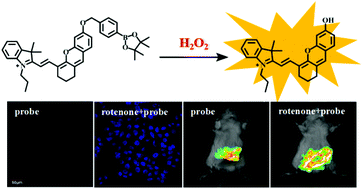Near-infrared fluorescence probe for hydrogen peroxide detection: design, synthesis, and application in living systems†
Abstract
Using fluorescent probes to detect endogenous hydrogen peroxide, which is associated with many diseases in the human body, remains an essential technique. Cyanine fluorochromes are a class of dyes that have attracted much attention and are widely used in the synthesis of fluorescent probes. In this article, a novel near-infrared (NIR) fluorescence probe for the detection of hydrogen peroxide was constructed and successfully applied to imaging endogenous hydrogen peroxide in vivo. Notably, probe 1 was designed by connecting 4-(bromomethyl)benzeneboronic acid pinacol ester as the sensing unit to the IR-780 hemicyanine skeleton, which exhibits excellent properties like NIR fluorescence emission over 700 nm. Probe 1 has satisfactory sensitivity to hydrogen peroxide with a low detection limit of 0.14 μM (S/N = 3), attributed to a responding mechanism that leads to the oxidation of phenylboronic acid pinacol ester and thereby releases fluorophore 2. Moreover, probe 1 displays excellent selectivity towards hydrogen peroxide over other substances. Taking advantage of these properties, the probe proved to be cell-permeable. Based on the results of N-acetylcysteine and rotenone together, probe 1 is capable of clearly visualizing endogenously produced hydrogen peroxide in living HepG2 cells and mice. The superior performance of the probe, as a reliable chemical tool, makes it of great potential application for exploring the role played by hydrogen peroxide in biological systems.



 Please wait while we load your content...
Please wait while we load your content...